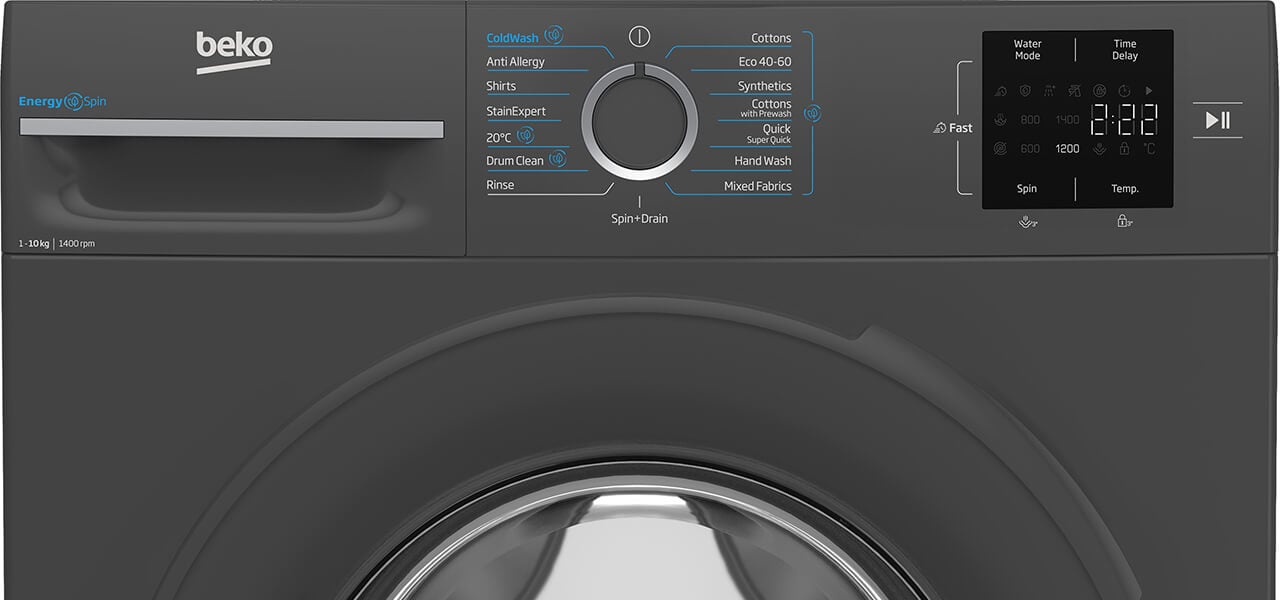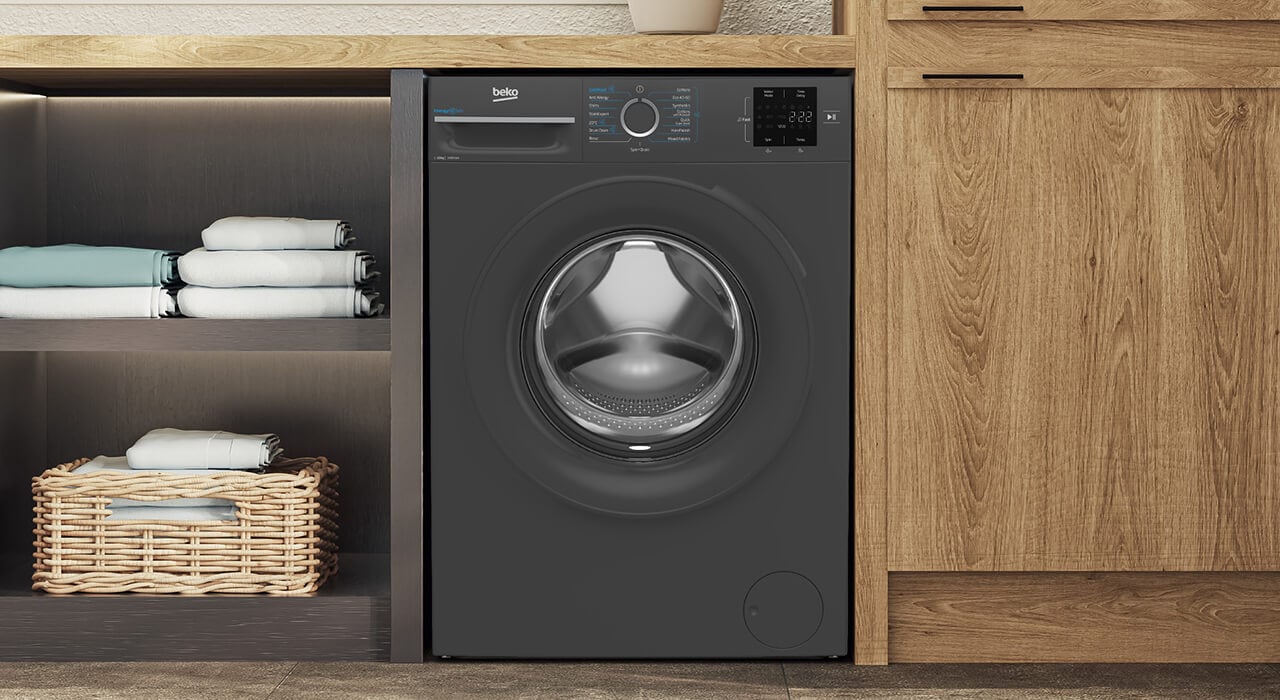Washing machine cycles and settings
When it comes to achieving the freshest laundry, understanding your washing machine's capabilities is key. Whether you're new to laundry or looking to optimise your washing process, having insights into each setting and cycle can make a significant difference. Luckily, our comprehensive guide is here to provide you with detailed explanations and advise that will allow you to maximise your washing machine's potential at home.

Common washing machine cycles
Depending on the model of your washing machine, you'll find a wide range of different wash cycles available, each designed to deliver the freshest laundry possible.
These common washing machine cycles may include:
- Cotton
- Hand wash or delicates
- Quick wash
- Wool wash
- Eco 40-60
- Drum clean cycle
- Rinse
- Soak
- Anti Allergy or Allergen
Some washing machines will also offer temperature settings for each cycle. You can adjust the temperature based on the soil level of your items, opting for a higher temperature for heavily soiled items or a cooler one for a more sustainable laundry routine.
Cotton cycle
A cotton cycle on a washing machine is ideal for washing items like towels and bedding, which typically require high agitation to achieve a thorough clean. This cycle provides the necessary movement to effectively clean your cotton laundry, using a high spin speed to remove dirt efficiently. However, it's important to note that this cycle is not suitable for delicate clothing items.
Hand wash or delicates wash
On your Beko washing machine, the delicate wash setting is referred to as a hand wash cycle, due to its gentle nature. The hand wash or delicate wash setting on your washing machine offers a gentle cycle, perfect for delicate clothing and items that require a softer touch during cleaning. Fabrics like silk and lace benefit from this gentle agitation to ensure proper cleaning without risking damage. With a slow spin speed, this cycle keeps items such as silk blouses and underwear safe from harm.
For soft toys with a “machine washable” care label, it's advisable to utilise the hand wash or delicate wash setting to preserve their fabric integrity.
Quick wash cycle
When you need fresh laundry in hurry, the quick wash setting on your washing machine is the perfect solution. This cycle completes your laundry in under half an hour, making it ideal for those last-minute outfit emergencies.
For optimal results, we recommend using the quick wash cycle for lightly soiled clothing only. Due to the rapid drum speed, it's advisable to remove delicate items from this wash whenever possible to prevent damage.
If you've got a small laundry load to run, a quick wash can be the best option to leave you with cleaner clothing. Getting the size of your laundry load right is important. A 10kg washing machine, for example, can easily manage 2kg of clothing on a super quick programme.
Wool wash setting
If you want to wash wool items in your machine, the wool setting is your go-to choice. For added convenience, at Beko, our wool wash setting is incorporated into our hand wash cycle. Similar to the delicate setting, this cycle is gentle, ensuring your woollens maintain their shape. The temperature typically hovers around 40 degrees Celsius to prevent shrinking.
However, unlike the delicate wash, the wool cycle concludes with a rinse spin featuring a high drum speed that rapidly removes excess water from your woollens, speeding up the drying process.
Eco 40-60
Using the eco mode on your washing machine is great for your laundry needs, especially if you're looking to lower your cycle cost and environmental footprint. This mode conserves water and energy by operating at a lower temperature compared to other cycles.

Drum clean cycle
The washing machine drum clean cycle is essential for maintaining the efficiency of your appliance and ensuring consistently fresh laundry. It thoroughly cleans your machine, removing limescale and buildup.
Some Beko washing machines come with a DrumClean+ programme for added convenience. Powered by steam, this helps to deep clean your drum and even remove odours.
To maximise the effectiveness of this cycle, make sure to run the programme with an empty drum. This will help to break down dirt and grime, leaving your washing machine sparkling clean.
Typically, this cycle uses hot water at 70 degrees Celsius or higher to tackle tough residues. We recommend using this programme once a month to maintain optimal performance and freshness in your laundry.
Learn more about cleaning your washing machine.
Sanitise cycle
A sanitise cycle on your washing machine is beneficial for removing bacteria and viruses from your clothes. This feature is especially useful if you or your family have been ill and need to thoroughly sanitise your garments. Some washer-dryers also offer high-temperature wash and dry cycles with this option.
At Beko, certain washer-dryers include our HygieneTherapy programme, which eliminates more than 99% of bacteria and viruses. The HygieneTherapy programme uses hot air at high temperatures to leave clothes perfectly clean and hygienic, without using water.
Rinse
The rinse cycle on your machine works to remove excess detergent or dirt from your clothing. Unlike the spin cycle, which primarily removes water from clothes, the rinse cycle involves both rinsing and spinning to ensure thorough cleaning without leaving garments wet. Temperature control options may be available for this cycle, allowing customisation based on your laundry needs.
Soak cycle
The soak cycle on a washing machine is great for delicate clothing or bulky items that need softer agitation, as well as longer contact with water and detergent to get clean. It starts with some brief agitation and then lets your items soak in the water before running a regular cycle. This is to help clean your heavily soiled clothes in the most efficient way, without needing to do multiple cycles.
Anti Allergy or Allergen
On your Beko washing machine, you'll find this cycle labelled as “Anti Allergy”. The anti-allergy cycle on a washing machine is specifically designed for households prone to allergies or with shedding pets.
In front-loading washers, this cycle runs through the standard process with an additional rinse. This rinse is tailored with different temperature and timing settings to effectively eliminate allergens such as pet hair, dust mites, and other common triggers.
SteamTherapy
Your Beko washing machine may also offer a SteamTherapy option. This convenient option is a quick, 15-minute programme that subjects your clothes to a tumble with high-temperature steam. Capable of accommodating up to 2lbs of dry clothing, it effectively reducing wrinkles by up to 58%.
Washing machine settings guide
To get the most out of your appliance, it's important to understand not only the cycles but also the washing machine settings. Exploring these settings helps you customise your laundry routine to suit your specific needs. From temperature and soil level to spin speed, understanding these settings allows to adjust agitation, water usage, and soak time for optimal results.
Temperature
The temperature setting on your washing machine determines the water's temperature during the cleaning process. You can either choose preset temperatures tailored to your clothing type or manually set the temperature yourself.
Washing machines offer a wide range of temperature options, from as low as 15 degrees Celsius to as high as 90 degrees Celsius. Opting for a cold wash can conserve energy, while hotter washes can be more effective at cleaning heavily soiled garments and eliminating bacteria.
Soil level
The soil level setting on your washing machine indicates how dirty your laundry load is, ranging from light to heavily soiled. Adjusting this setting ensures that the machine knows how long of a cycle is necessary and how much detergent to use for optimal cleaning.
Spin speed
The spin setting on your washing machine affects how damp your clothes are when they come out. Opting for a high spin setting is ideal for sturdy materials like denim, as it helps to reduce drying times, while a low spin speed is gentler and more suitable for delicate items.
Find out more about what your spin speed means.

Washing machine programmes
Whether you're looking for a gentle programme for delicate garments or a quick wash for ultimate convenience, your washing machine will come with pre-programmed settings designed to cater to various laundry needs.
Since every family has their own unique laundry routine, it's important to find a machine that aligns with your specific needs. Check out our washing machine buying guide for more information.
Pre-wash
The pre-wash setting on your washing machine is intended for heavily soiled items. It starts with a cold-water cycle before your selected washing cycle, allowing your clothes to soak. To use the pre-wash cycle, simply add detergent to your pre-wash drawer and select the programme. It's worth noting that you cannot use the pre-wash programme when running delicate, wool, quick wash, or rinse and spin cycles.
Cycle times
The typical duration of a washing machine cycle is approximately 50 minutes. However, this timeframe may vary based on factors such as the size of your laundry load, the level of soiling, and other considerations. While certain models offer quick wash options that can complete a cycle in as little as 15 minutes, it's generally recommended to opt for the 30-minute setting for optimal results.
Choosing the right washing machine cycle and settings
To achieve the cleanest laundry, you'll want to make sure your washing machine cycle and settings are properly adjusted. Whether it's managing the temperature control or setting the cycle time, providing tailored care to each load is essential for maintaining the freshness of your clothing. By separating your laundry and treating each load individually, you can ensure that your clothes receive the best possible cleaning results.
You'll want to keep in mind:
Fabric type
Depending on what you've put in your drum, you will need different cycles and settings for optimal cleaning. Pre-programmed cycles like ‘delicates' are ideal for delicate fabrics that require gentle care and minimal agitation. Wool has its own specific cycle due its unique absorption and reaction to heat. When sorting your clothing, aim to group similar fabric types and colours together to facilitate efficient washing and easy setting control.
Specific needs
Different laundry loads require specific treatment. Whether it's a white wash that requires high heat to maintain brightness or a quick wash for last-minute needs, adjusting temperature and cycle speeds is crucial. Sorting laundry beforehand can simplify the selection of the appropriate cycle and settings.
Our Beko washing machines offer specialised cycles tailored to your needs, including uncommon duvet, curtains, or shirt programmes. Programmes such as StainExpert and Sports can help with heavily soiled items and for providing your laundry pile with tailored treatment. Each programme is customised to ensure efficient cleaning for these items. Always check the care labels on your garments before placing them in the washing machine.

Duvet
If your duvet is machine washable, use this programme for optimal cleaning. Duvets, being bulky items, require individual care. Before loading your duvet into the washing machine, remove the duvet cover and fold the duvet in half. It is important that you do not load anything larger than a double fibre 200x200cm duvet into the drum.
This specific programme can also effectively clean feather-filled clothing such as jackets, coats, and vests. However, always check for a “machine washable” symbol on the care label before washing.
Curtains
Curtains present a unique challenge when it comes to washing due to their mesh design, which can generate high levels of foam in the drum. For optimal cleaning, you'll want to utilise the curtain-specific programme on your Beko washing machine.
This programme requires less detergent, as tulle and mesh fabrics require only a small amount for effective cleaning. Additionally, the special spin cycle in this programme reduces creasing, allowing your curtains to be rehung with minimal wrinkles.
Shirts
Sorting your shirts individually can be a tedious task. That's why, at Beko, we offer a pre-programmed shirts cycle designed to wash your cotton, synthetic, and synthetic blended fabric shirts together.
This programme includes a steam treatment that effectively reduces the wrinkles on each shirt in your drum, streamlining the drying and ironing process as soon as you open your washing machine door.
Energy efficiency
If you're aiming to reduce costs or enhance energy efficiency, adjusting the cycles and settings on your washing machine can be beneficial. Opting for shorter cycles and cooler water could decrease energy consumption significantly during the wash.
Depending on your washing machine, you will have different cycles and programmes available to you. Using the right programme for the type of wash you're after is important to ensure you're getting a thorough clean every time. Knowing your washing machine settings better means you can tailor your cycles to your clothing, giving you great cleaning action with each wash.
If energy efficiency is a priority for you, you can learn more about your washing machine's energy and water usage with each cycle. To see how efficient your machine, refer to our guide to reading your energy rating labels or check your machine's user manual.
Additionally, it's important to consider the type and amount of detergent you use. The required amount of detergent can vary depending on the water softness level in your area. Always check the detergent label for recommended dosages to ensure optimal cleaning performance and avoid using too much or too little detergent.
Did we answer your question?
We are so sorry we were unable to answer your question. You might be able to find the answer you are looking for in the ‘Related Questions’ below. If your query is still unanswered, please head over to our Contact Us page for further assistance.
Search FAQ’s
Search or browse our frequently asked questions to find the answer to your query.




